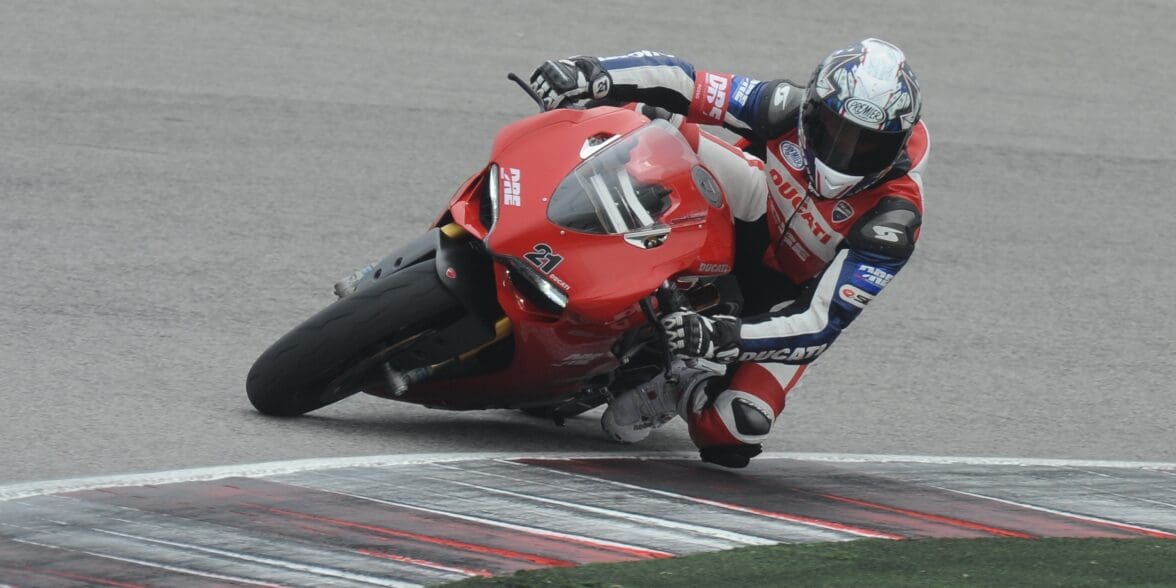The Ducati Panigale is one hot bike.
Not just because it’s Italy’s most powerful production bike, Ducati’s fastest yet and designed with Italian passion.
No, it’s also hot because your bum and legs will burn in the heat pouring out of the fairing.
But that’s ok. This is not an everyday, ride-to-the-shops-in-your-jeans type of bike.
This is a dedicated weapon that is designed to be ridden hard and will be the finest precision instrument on a track.
Others have criticised it for its no-nonsense suspension, only to find that with the almost infinitely electronic adjustable springs and dampers, you can set it up for most conditions.
The Panigale range starts at $26,990 with the “standard” Panigale. The S models costs $33,990, the S Tricolore $39,990 and the R is $42,990.
The standard Panigale comes with a Sachs rear shock and Marzocchi forks and doesn’t feature the electronically adjustable Ohlins suspension of the S and R. Yet it has all the other electronic wizardry you could want … and more.
It all starts with the new instrument panel which is the control panel for all the electronic adjustment as well as providing a stunningly comprehensive array of mind-boggling information.
The display even adjusts itself according to selected riding modes. Select the engine maps for “Road” or “Wet” conditions and the speed is the dominant feature in the display. Select “Race” and the speed is demoted to a corner with lap time dominating the screen.
In Race mode the rev counter also changes with the increments up to 40000rpm only minimal and emphasis on the rest of the revs up to the 10,500rpm limit.
It also comes with traction control with eight adjustable levels in each of the rider modes.
The quick shift system is electronic and allows upshifts under heavy acceleration without use of the clutch simply by slightly retarding the engine at the point of cog swapping.
There is also an engine braking control system working alongside the slipper clutch to make rear wheel lockup a thing of the past.
In fact, bang it down aggressively in the gears and the engine revs blip to match wheel speed making you sound like a real pro.
All Panigale models come with three-level switchable ABS. Race ABS is front only, Wet is rear-wheel biased.
You can also get ABS 9ME which controls the lift of the rear tyre allowing partial “stoppies” while providing the shortest stopping distance.
It’s an option in the standard and S, but standard on the Tricolore and R.
We rode the Panigale S in intermittent rain and chose the Wet setting to start.
This limits the engine power to 89kW and also adjusts the ABS.
It felt quite controllable, but not very exciting, so we quickly slipped through to Sport setting for the maximum power of 145kW, but with emphasis on the mid-range.
Now it simply snapped into life and the throttle felt twitchy and excitable.
The world blurred into an impressionist painting as we hurtled forward, but still no rear wheel spin.
Then we threw the dice and dialed in Race which puts the emphasis on the top end of the rev range, however we simply ran out of road and could never get anywhere near its potential.
Just knowing those limits are out there, sends shivers up your spine, which is a nice balance to the heat on the legs.
The adjustments for suspension appear limitless and the quick tutorial by Ducati Australia’s Craig McMartin seemed more confusing than informative.
However, once out on the road and experimenting with the various modes and adjustments, it’s actually quite easy. Although it’s not quick and you wouldn’t want to make some of the changes on the fly. You simply have to keep your eyes on the road as everything is flying by at a great rate.
Even on its softest settings and in Wet mode the ride around the urban landscape is harsh and jittery.
But it felt precise and sharp, turning into corners almost on ESP rather than handlebar input.
Riding position is not quite as prone as it has been in past models nor as head-down-bum-up as its sister Italian MV Agusta F4.
And the seat is a plank. But this is not set up for long trips in the saddle. In fact, most people will enjoy the ease with which you can slide side to side around the ultra-narrow and well-shaped tank to shift your weight for cornering and knee-down jollies.
Central to the love of this bike is the Superquadro L-twin Desmodromic engine.
Its note is typically Italian with a lot of gesticulating and emotion. It simply loves to scream and doesn’t like to be ridden under 4000rpm.
Thankfully it has a self-servo wet multiplate clutch, so no annoying clattering at the lights with the clutch pulled in, although some Ducatisti don’t think it’s a real Duc unless it has a noisy dry clutch.
When it comes time to stop, the brakes are sharp and touchy, but the ABS system is well set up for panic stops with confidence.
It all comes with a two-year, unlimited kilometre warranty and now with 12,000km service intervals.
Have we also mentioned it’s one of the sexiest looking sportsbikes on the market?
When you want the sharpest tool for the toughest job, this is the stylish choice.
Ducati Panigale
Prices: Panigale Dark $26,990, S $33,990, S Tricolore $39,990 and R $42,990
Engine: 1198cc liquid cooled, Superquadro, L-twin cylinder, 4-valve, Desmodromic
Power: 143kW @ 10750rpm
Torque: 132Nm @ 9000rpm
Transmission: 6 speed
Suspension: Marzocchi 50mm USD fork, Sachs rear shock (S, S Tricolore and R have Ohlins suspension)
Tyres: 120/70 ZR17; 200/55 ZR17 Pirelli Diablo Supercorsa SP
Brakes: 330/245mm discs, Brembo front callipers, ABS
Wet weight: 188kg
Seat: 825mm
Fuel:17 litres



